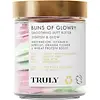What's inside
What's inside
 Key Ingredients
Key Ingredients

 Benefits
Benefits

 Concerns
Concerns

 Ingredients Side-by-side
Ingredients Side-by-side

Butyrospermum Parkii Butter
Skin ConditioningCocos Nucifera Oil
MaskingButter
Skin ConditioningMangifera Indica Seed Oil
EmollientPrunus Amygdalus Dulcis Oil
Skin ConditioningSimmondsia Chinensis Seed Oil
EmollientTheobroma Cacao Seed Butter
EmollientTocopherol
AntioxidantMelia Azadirachta Leaf Extract
Skin ConditioningMelia Azadirachta Flower Extract
Skin ConditioningCoccinia Indica Fruit Extract
Skin ConditioningCorallina Officinalis Extract
Skin ConditioningLeuconostoc/Radish Root Ferment Filtrate
AntimicrobialLonicera Japonica Flower Extract
Skin ConditioningLonicera Caprifolium Flower Extract
PerfumingPopulus Tremuloides Bark Extract
AntiseborrhoeicGluconolactone
Skin ConditioningHydrogenated Soybean Oil
EmollientPhenoxyethanol
PreservativeHydrolyzed Wheat Protein
Skin ConditioningWater
Skin ConditioningCitrullus Lanatus Fruit Extract
Skin ConditioningTetrasodium Glutamate Diacetate
Propylene Glycol
HumectantCitrus Aurantium Amara Flower Extract
RefreshingPrunus Armeniaca Fruit Extract
Skin ConditioningParfum
MaskingMica
Cosmetic ColorantTitanium Dioxide
Cosmetic ColorantCI 77492
Cosmetic ColorantButyrospermum Parkii Butter, Cocos Nucifera Oil, Butter, Mangifera Indica Seed Oil, Prunus Amygdalus Dulcis Oil, Simmondsia Chinensis Seed Oil, Theobroma Cacao Seed Butter, Tocopherol, Melia Azadirachta Leaf Extract, Melia Azadirachta Flower Extract, Coccinia Indica Fruit Extract, Corallina Officinalis Extract, Leuconostoc/Radish Root Ferment Filtrate, Lonicera Japonica Flower Extract, Lonicera Caprifolium Flower Extract, Populus Tremuloides Bark Extract, Gluconolactone, Hydrogenated Soybean Oil, Phenoxyethanol, Hydrolyzed Wheat Protein, Water, Citrullus Lanatus Fruit Extract, Tetrasodium Glutamate Diacetate, Propylene Glycol, Citrus Aurantium Amara Flower Extract, Prunus Armeniaca Fruit Extract, Parfum, Mica, Titanium Dioxide, CI 77492
Water
Skin ConditioningC12-15 Alkyl Benzoate
AntimicrobialCetyl Alcohol
EmollientCetearyl Alcohol
EmollientGlyceryl Stearate Citrate
EmollientKaolin
AbrasiveGlycerin
HumectantSodium Benzoate
MaskingXanthan Gum
EmulsifyingChlorphenesin
AntimicrobialDisodium EDTA
Schinus Terebinthifolia Seed Extract
AstringentSodium Hyaluronate
HumectantPaullinia Cupana Seed Extract
Skin ConditioningIlex Paraguariensis Leaf Extract
PerfumingCaffeine
Skin ConditioningCoffea Arabica Seed Extract
MaskingSoluble Collagen
HumectantHydrolyzed Elastin
EmollientGlyceryl Caprylate
EmollientCitric Acid
BufferingEthylhexylglycerin
Skin ConditioningVanillyl Butyl Ether
MaskingLaureth-7
EmulsifyingPhenoxyethanol
PreservativePolyacrylamide
C13-14 Isoparaffin
EmollientPvp
Emulsion StabilisingParfum
MaskingBenzyl Salicylate
PerfumingBenzyl Alcohol
PerfumingLinalool
PerfumingHydroxycitronellal
PerfumingHexyl Cinnamal
PerfumingLimonene
PerfumingCI 42090
Cosmetic ColorantCI 16035
Cosmetic ColorantWater, C12-15 Alkyl Benzoate, Cetyl Alcohol, Cetearyl Alcohol, Glyceryl Stearate Citrate, Kaolin, Glycerin, Sodium Benzoate, Xanthan Gum, Chlorphenesin, Disodium EDTA, Schinus Terebinthifolia Seed Extract, Sodium Hyaluronate, Paullinia Cupana Seed Extract, Ilex Paraguariensis Leaf Extract, Caffeine, Coffea Arabica Seed Extract, Soluble Collagen, Hydrolyzed Elastin, Glyceryl Caprylate, Citric Acid, Ethylhexylglycerin, Vanillyl Butyl Ether, Laureth-7, Phenoxyethanol, Polyacrylamide, C13-14 Isoparaffin, Pvp, Parfum, Benzyl Salicylate, Benzyl Alcohol, Linalool, Hydroxycitronellal, Hexyl Cinnamal, Limonene, CI 42090, CI 16035
Ingredients Explained
These ingredients are found in both products.
Ingredients higher up in an ingredient list are typically present in a larger amount.
Parfum is a catch-all term for an ingredient or more that is used to give a scent to products.
Also called "fragrance", this ingredient can be a blend of hundreds of chemicals or plant oils. This means every product with "fragrance" or "parfum" in the ingredients list is a different mixture.
For instance, Habanolide is a proprietary trade name for a specific aroma chemical. When used as a fragrance ingredient in cosmetics, most aroma chemicals fall under the broad labeling category of “FRAGRANCE” or “PARFUM” according to EU and US regulations.
The term 'parfum' or 'fragrance' is not regulated in many countries. In many cases, it is up to the brand to define this term.
For instance, many brands choose to label themselves as "fragrance-free" because they are not using synthetic fragrances. However, their products may still contain ingredients such as essential oils that are considered a fragrance by INCI standards.
One example is Calendula flower extract. Calendula is an essential oil that still imparts a scent or 'fragrance'.
Depending on the blend, the ingredients in the mixture can cause allergies and sensitivities on the skin. Some ingredients that are known EU allergens include linalool and citronellol.
Parfum can also be used to mask or cover an unpleasant scent.
The bottom line is: not all fragrances/parfum/ingredients are created equally. If you are worried about fragrances, we recommend taking a closer look at an ingredient. And of course, we always recommend speaking with a professional.
Learn more about ParfumPhenoxyethanol is a preservative that has germicide, antimicrobial, and aromatic properties. Studies show that phenoxyethanol can prevent microbial growth. By itself, it has a scent that is similar to that of a rose.
It's often used in formulations along with Caprylyl Glycol to preserve the shelf life of products.
Water. It's the most common cosmetic ingredient of all. You'll usually see it at the top of ingredient lists, meaning that it makes up the largest part of the product.
So why is it so popular? Water most often acts as a solvent - this means that it helps dissolve other ingredients into the formulation.
You'll also recognize water as that liquid we all need to stay alive. If you see this, drink a glass of water. Stay hydrated!
Learn more about Water